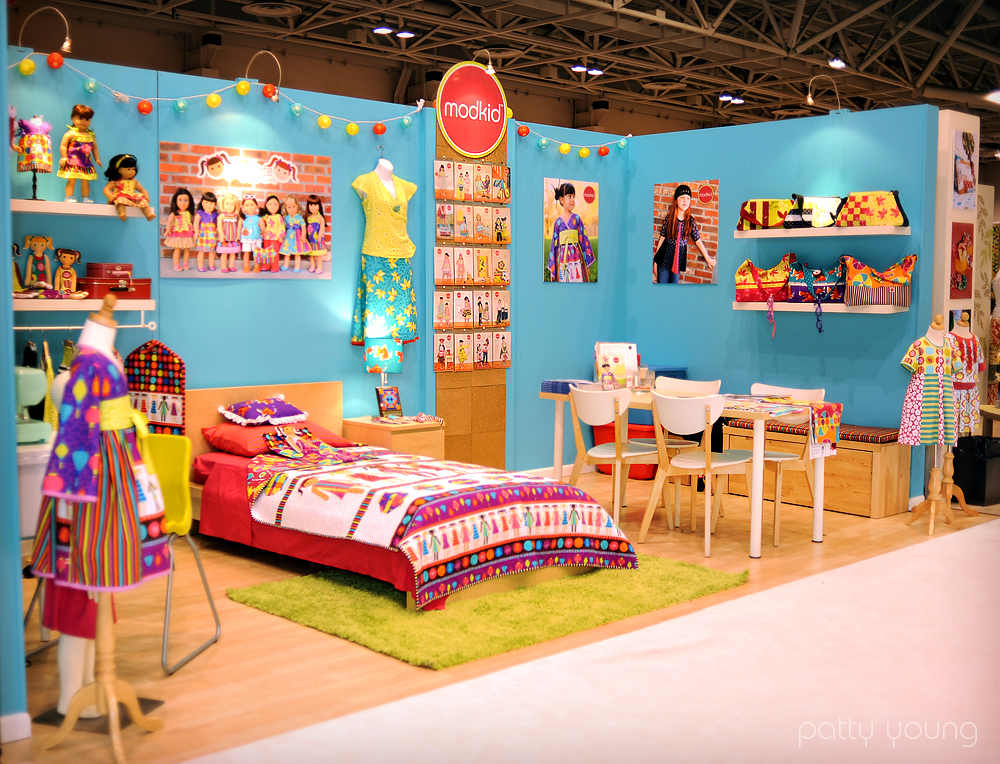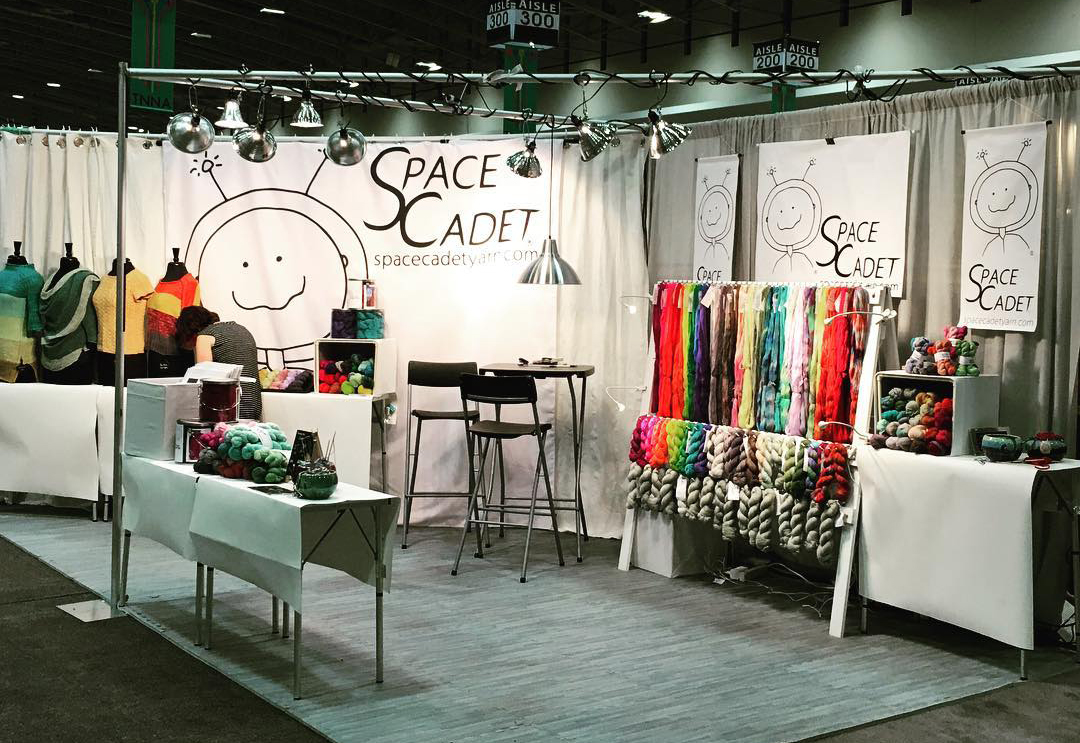
Playdate booth by Patty Young for ModKid at Spring Quilt Market 2010.
Photo courtesy of Patty Young.
But when you factor in the cost of traveling and setting up eye-catching displays — and the time it takes to recover and follow up, afterward — trade shows are also a hefty investment.
We spoke to exhibitors at The National NeedleArts Association (TNNA)’s biannual trade show, and other trade shows such as Quilt Market and Surtex, to get their top tips for a successful show.
Know your goals
Stephanie Alford, the owner of SpaceCadet, a hand-dyed yarn business, exhibited at the TNNA for the first time this year, doing both the winter show in San Diego in January and the summer show in Washington, D.C. in June. She saw the show as a way to build on the wholesale business she had already established.
“We’d been doing wholesale for a few years and attracted customers through a number of different ways: by being seen at retail shows, via email marketing, and word of mouth (their customers asking for our yarn in their shop),” Alford says. “For us, exhibiting at a trade show is about building on that foundation, adding legitimacy to the brand, strengthening connections with existing customers, making connections with designers and other industry folk and also adding new accounts.”
“Knowing your goals also helps to assess whether the show was a success afterwards,” Alford says. “You won’t be able to achieve every possible thing in one weekend, so having concrete goals helps you to see what you did accomplish and not get hung up on what you didn’t.”
Julia Hilbrandt, who exhibited with her handmade felt bags for the first time at TNNA in June, stresses that it is important to know your production schedule, including how much you can book and how quickly.
“Don’t promise everyone the world immediately,” Hilbrandt says. “The shows don’t always pan out as you would like for sales, but long-term has to be the goal.”

Felt bag by Julia Hilbrandt.
Photo courtesy of Julia Hilbrandt.
Ready your booth early
It’s a good idea to start planning your space months in advance, says Patty Young, a licensed textile designer who also owns Modkid, creating and selling sewing patterns for children’s clothes, doll outfits, purses and other accessories.
“These things don’t happen overnight and sometimes you even have to budget for all the things you need to include in the booth,” says Young, who exhibited twice a year at Quilt Market between 2008 and 2014 and once at Surtex in spring of 2011. “Exhibiting is expensive!”
Visitors to your booth should also be able to easily understand what you offer.
“Be clear about what you are showing or selling,” Young says. “Remember that the show attendees are looking at literally hundreds of booths a day, so if they come to yours and are confused about what you are showing or selling, they will walk on by and not even look back.”
Alford recommends setting up a booth mock-up ahead of time and walking a friend through it as if they were a customer, to get feedback before the show.
Be prepared
Expect that something will go wrong and prepare beforehand. Check maps to find hardware stores close to the convention center and bring spares items if you can fit them, Alford says.
It’s also valuable to take notes. Alford recommends writing everything down in a big notebook and attaching business cards to the relevant pages with a stapler. You can also use Evernote to snap photos of all your notes and cards.
“If you can, take an assistant who understands that it’s their job to make notes on the conversations you have while you’re having them, so you don’t have to interrupt your flow, but all the important details get jotted down while they’re fresh,” she says. “You’re going to have a lot of conversations that you want to follow up on and wish you could remember all those pesky details later.”

Space Cadet Yarn’s TNNA booth
Photo courtesy of Stephanie Alford.
Seek out opportunities beyond selling
Along with wholesale accounts, trade shows often provide more intangible connections and insights, such as learning what wholesale customers really want and exposure via the publishers, bloggers and podcasters walking the floor.
“Since there are so many bloggers who attend, your name and face pretty much gets plastered all over social media when you have a booth at Quilt Market,” Young says.
Young was approached by publishers at Quilt Market and was featured in several sewing publications after meeting editors at the show and the events surrounding it.
At TNNA, Hilbrandt got valuable feedback from shops on design and style details for her bags and tips from other vendors about working with shops, ideas for making her business run smoother and suggestions for exhibiting at other trade shows.
Follow up
The work isn’t done once your booth is all packed up. A lot of valuable trade-show accomplishments could fall by the wayside if you don’t use the business cards you’ve collected and notes you’ve taken to follow up.
Re-orders will be key to giving Hilbrandt insight into whether her inaugural TNNA was a success, she says.
Young urges business owners to not get discouraged if their first booth doesn’t turn them into an overnight success.
“These things take time and repetition is key,” Young says. “When they see your face and your name again the next year, they will remember you if you made a good impression the first time. Not everyone buys at the show. Most are there to collect information so they can make a more educated decision later.”

Lisa Chamoff
contributor
Lisa is a freelance journalist in the New York Metro area who specializes in home design, real estate and healthcare. When she’s not writing, or knitting shawls and sweaters, Lisa runs Indie Untangled (www.indieuntangled.com), a marketplace and blog that promotes the work of yarn dyers, pattern designers and crafters of knitting-related accessories.

Trackbacks/Pingbacks